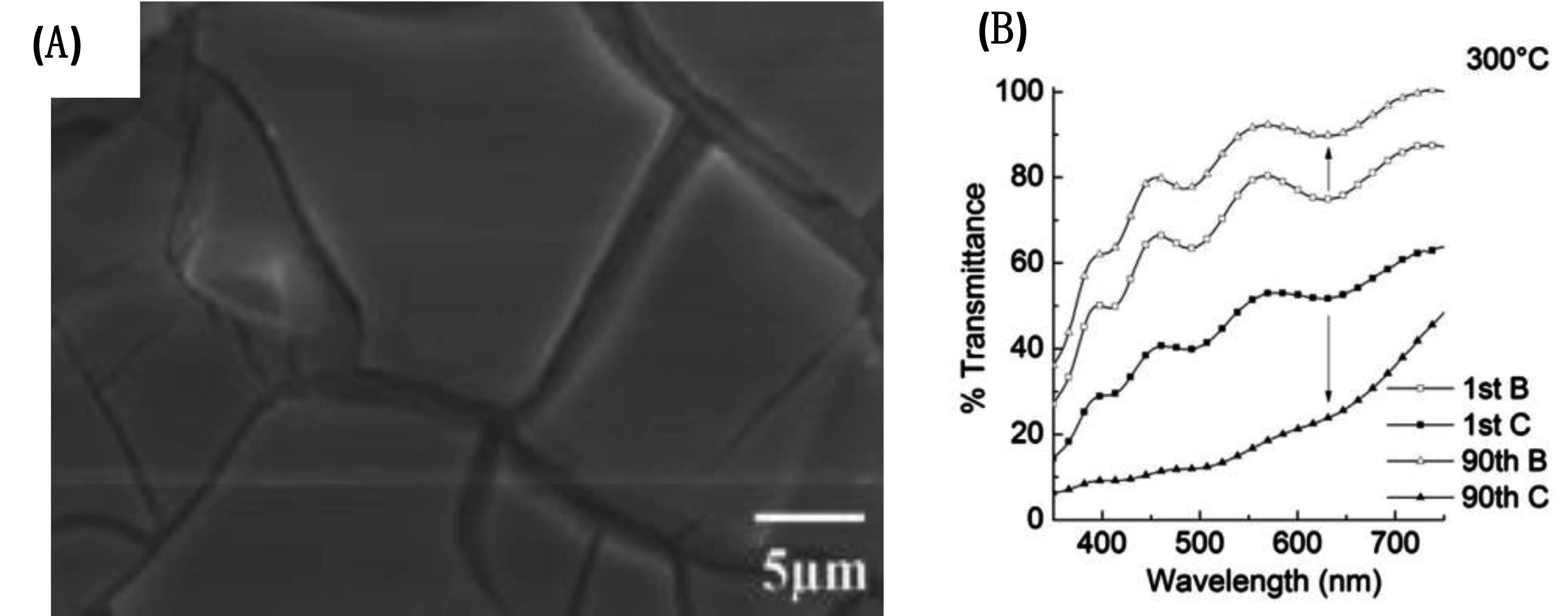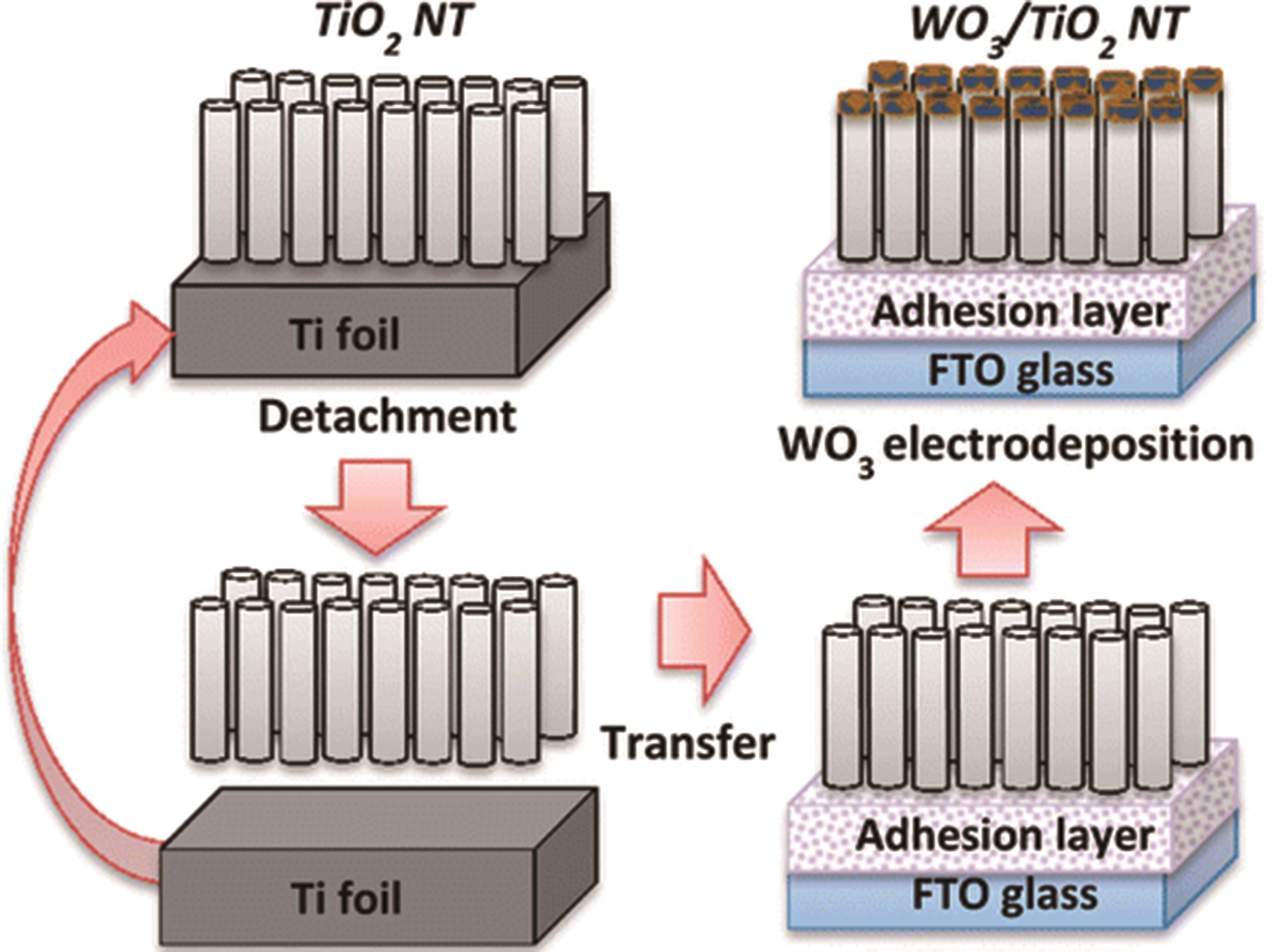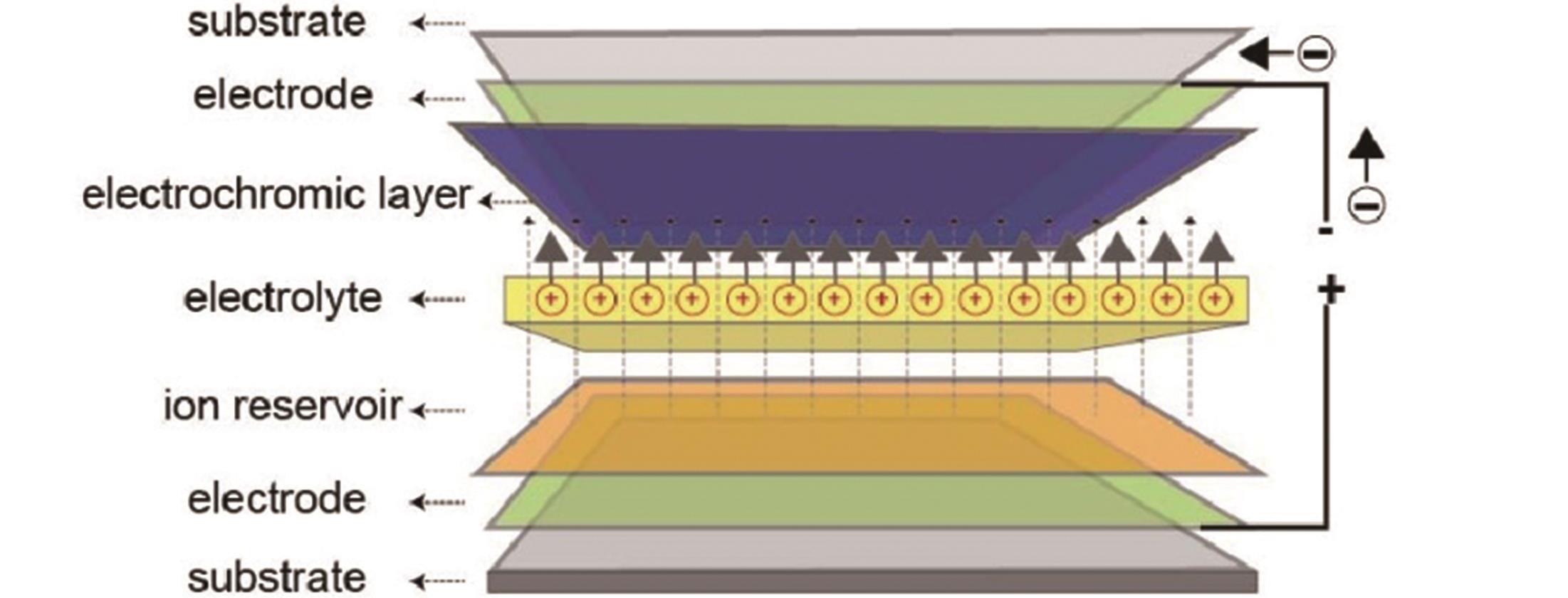
Chinese Journal of Applied Chemistry ›› 2022, Vol. 39 ›› Issue (9): 1345-1359.DOI: 10.19894/j.issn.1000-0518.220049
• Review • Previous Articles Next Articles
Advances of Inorganic‑inorganic Composite Electrochromic Films
Xin GU, Wen-Qing WANG, Jun-He HOU, Lu GAO, Ming-Hua HUANG, Ge SU( )
)
- School of Materials Science and Engineering,Ocean University of China,Qingdao 266100,China
-
Received:2022-02-25Accepted:2022-05-31Published:2022-09-01Online:2022-09-08 -
Contact:Ge SU -
About author:gesu@ouc.edu.cn
-
Supported by:the Natural Science Foundation of China(21775142)
CLC Number:
Cite this article
Xin GU, Wen-Qing WANG, Jun-He HOU, Lu GAO, Ming-Hua HUANG, Ge SU. Advances of Inorganic‑inorganic Composite Electrochromic Films[J]. Chinese Journal of Applied Chemistry, 2022, 39(9): 1345-1359.
share this article
Add to citation manager EndNote|Ris|BibTeX
URL: http://yyhx.ciac.jl.cn/EN/10.19894/j.issn.1000-0518.220049
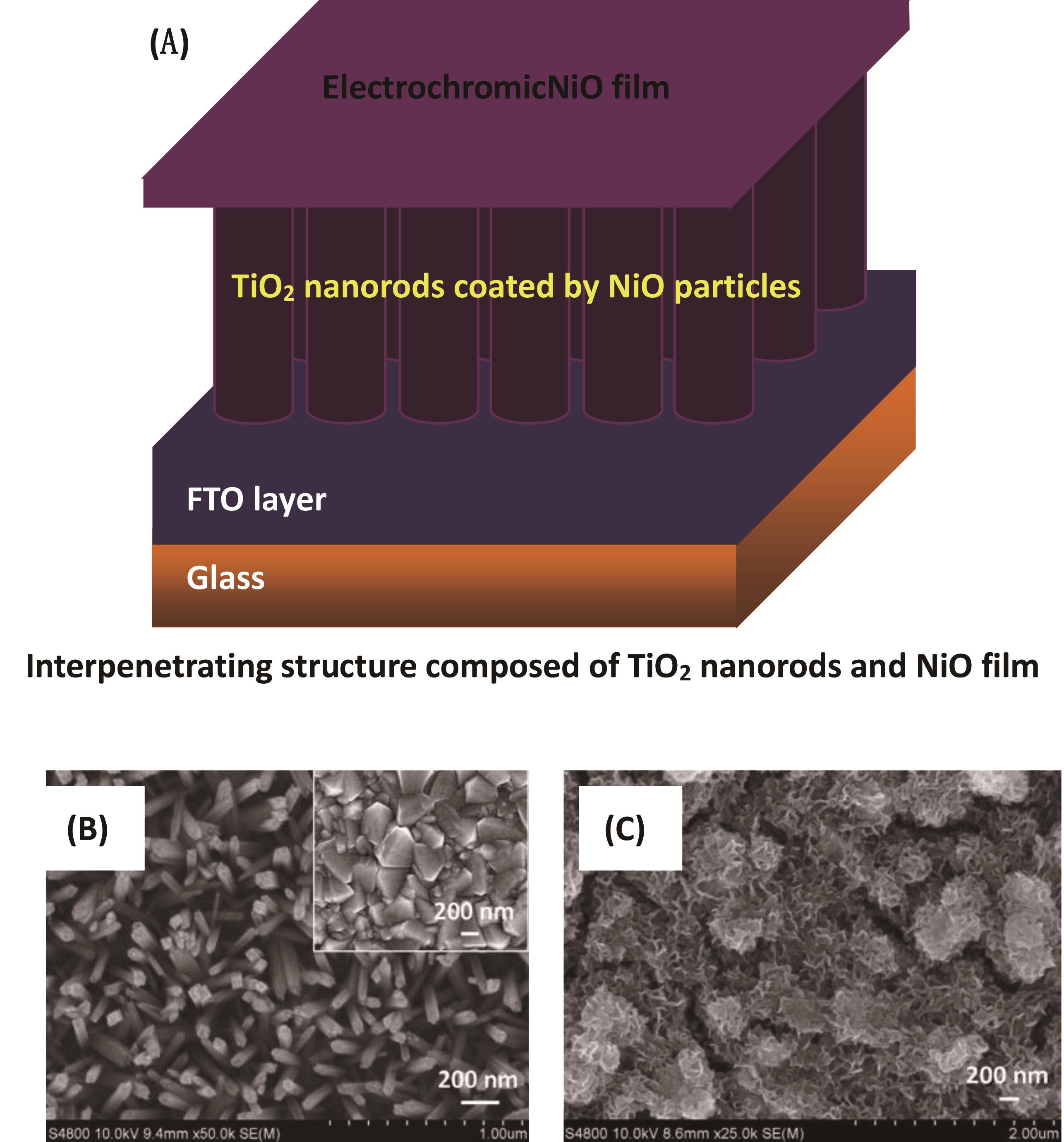
Fig.3 (A) Structure diagram of the NiO-TiO2 film with interpenetrating composite structure; (B) SEM image of TiO2 nanorod array, the inset picture is the SEM image of the FTO substrate; (C) SEM image of NiO-TiO2 composite film[34]
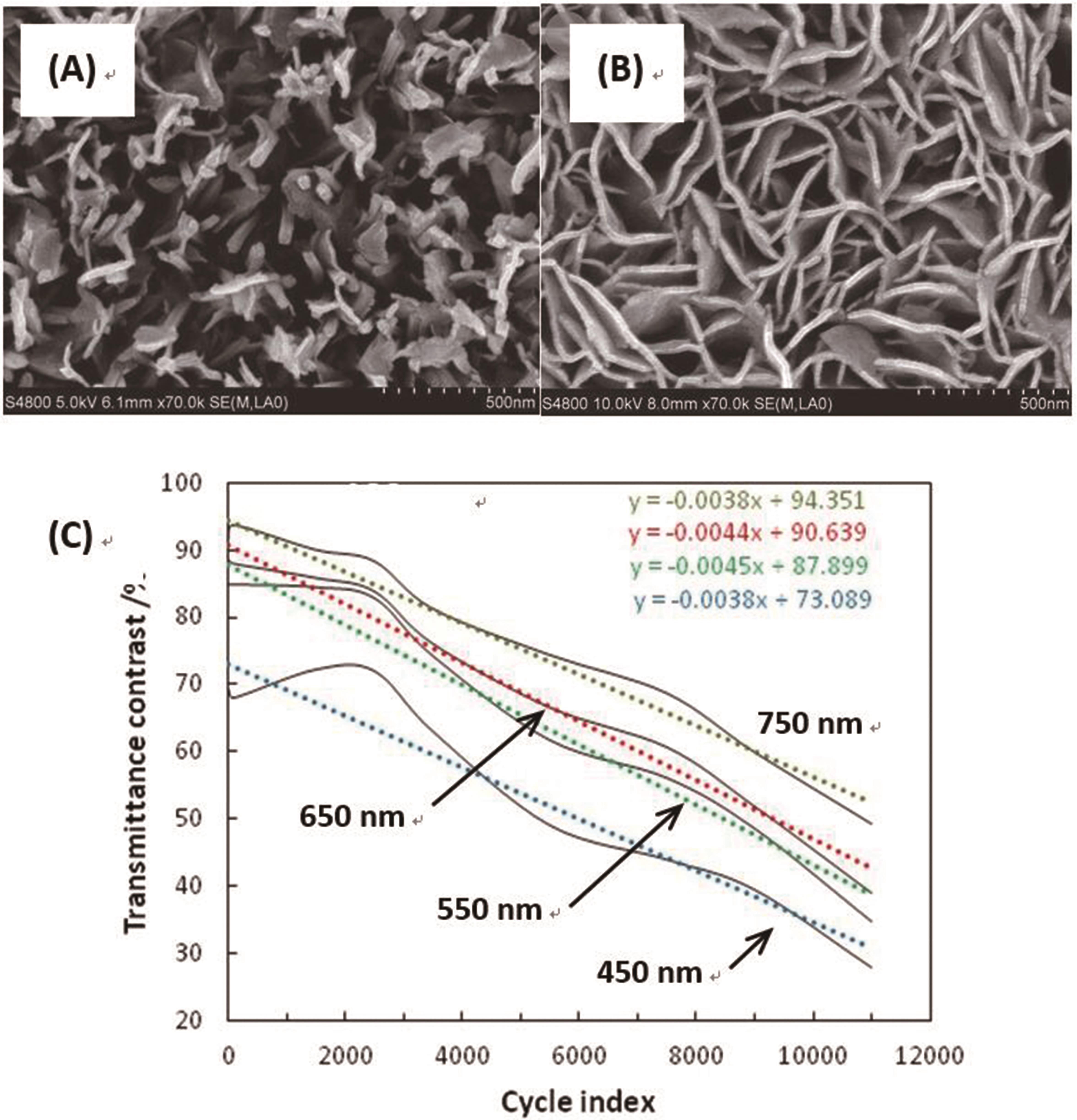
Fig.4 SEM images of Ni(OH)2-TiO2 composite films prepared by deposition of Ni(OH)2 on the TiO2 nanorods for 135 min (A) and 360 min (B); Rlationship between light modulation at different wavelengths and the cycle index of the composite film as shown in figure B (C). The solid line is the test data and the dotted line is the fitting value[39]
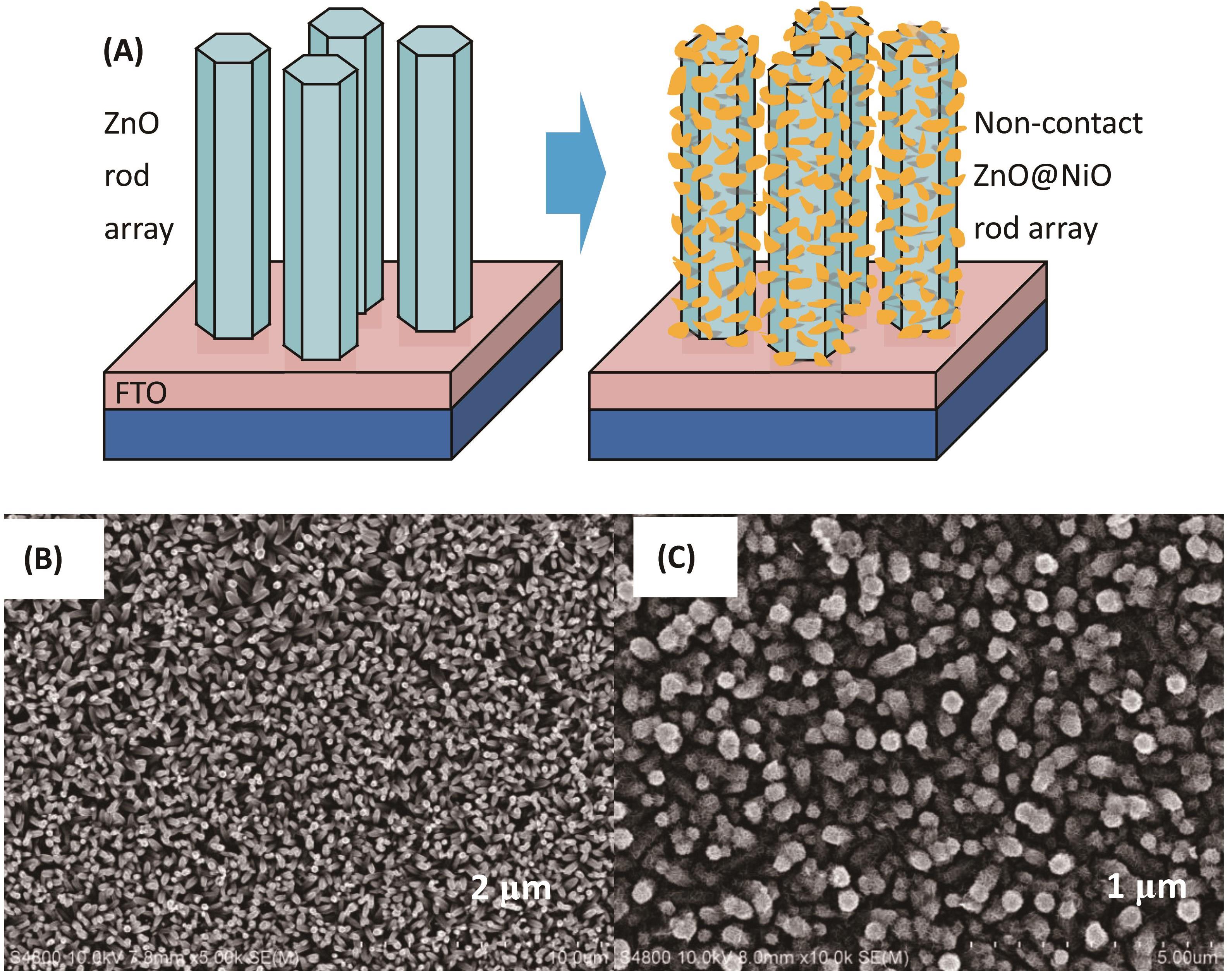
Fig.5 Schematic diagram of the construction process of the ZnO-NiO film with non-contact core-shell rod array structure (A); SEM images of the ZnO rod array film (B) and ZnO-NiO core-shell rod array film (C) [41]

Fig.7 SEM images of In2O3 rod array (A) and Ni(OH)2-In2O3 rod composite film (B); Energy band position diagram of FTO and In2O3 (C); Diagrams of FTO/In2O3 heterojunction (D)[49]
复合材料 Composite materials | 着色时间/ 消色时间 Coloration time(s)/ Bleaching time(s) | 着色效率 Coloration efficiency /(cm2·C-1) | 光学调制 (考查波长) Light modulation/% (Wavelength/nm) | 循环次数 Cycle index | 参考文献 Refs |
|---|---|---|---|---|---|
| NiO?ZnO | 2.6/9.7 | 78.5 | 81.0 (550) | - | [ |
ZnO?NiO棒阵列 ZnO?NiO rod array | <1 | <1 | - | 12 000 | [ |
| WO3?Ag | 3.9/8.9 | 90.2 | 40.6 (633) | - | [ |
| CuWO4?WO3 | 1.9/1.6 | 74.4 | 54.6 (800) | - | [ |
| WO3?ITO | 5.7/0.9 | 35.8 | 53.6 (633) | - | [ |
| C?V2O5 | 3.6/3.1 | 89.3 | 45.8 (650) | 5 000 | [ |
| MoO3?V2O5 | 8.2/6.3 | - | 31.4 (700) | - | [ |
| V2O5?GO | 1.4/2.5 | - | 40.9 (415) | - | [ |
NiO?普鲁士蓝 NiO?Prussian blue | 5.0/6.0 | 141.0 | 46.0 (700) | - | [ |
| NiO?TiO2 | 3.8/4.0 | 147.6 | 71.0 (550) | 3 000 | [ |
NiO?多壁碳纳米管 NiO?MWCNT | 8.1/6.6 | 31.1 | - | 5 000 | [ |
| NiO?rGO | 4.3/3.9 | 12.9 | 40.7 (550) | 1 000 | [ |
TiO2?普鲁士蓝 TiO2?Prussian blue | 6.2/2.2 | 131.5 | 48.0 (700) | - | [ |
| TiO2?Co3O4 | - | 91.0 | 40.0 (423) | 5 000 | [ |
| Ni?NiO?rGO | 4.2/2.4 | 48.2 | 51.6 (550) | - | [ |
V2O5?石墨烯 V2O5?graphene | - | 555.8 | 68.9 (800) | - | [ |
| WO3?rGO | 4.7/4.5 | 181.5 | 58.8 (633) | 2 500 | [ |
| WO3?MoO3 | 25.0/25.0 | 91.0 | 57.0 (650) | - | [ |
| WO3?TiO2 | 3.0/1.1 | 102.1 | 85.3 (633) | 3 000 | [ |
| Ni(OH)2?TiO2 | 0.4/1.2 | 95.3 | 89.0(550) | 11 000 | [ |
| In2O3?Ni(OH)2 | 8.0/3.0 | 101.4 | 61.6(550) | 6 500 | [ |
Table 1 EC properties of inorganic?inorganic composite materials obtained by different methods from 2016 to 2021
复合材料 Composite materials | 着色时间/ 消色时间 Coloration time(s)/ Bleaching time(s) | 着色效率 Coloration efficiency /(cm2·C-1) | 光学调制 (考查波长) Light modulation/% (Wavelength/nm) | 循环次数 Cycle index | 参考文献 Refs |
|---|---|---|---|---|---|
| NiO?ZnO | 2.6/9.7 | 78.5 | 81.0 (550) | - | [ |
ZnO?NiO棒阵列 ZnO?NiO rod array | <1 | <1 | - | 12 000 | [ |
| WO3?Ag | 3.9/8.9 | 90.2 | 40.6 (633) | - | [ |
| CuWO4?WO3 | 1.9/1.6 | 74.4 | 54.6 (800) | - | [ |
| WO3?ITO | 5.7/0.9 | 35.8 | 53.6 (633) | - | [ |
| C?V2O5 | 3.6/3.1 | 89.3 | 45.8 (650) | 5 000 | [ |
| MoO3?V2O5 | 8.2/6.3 | - | 31.4 (700) | - | [ |
| V2O5?GO | 1.4/2.5 | - | 40.9 (415) | - | [ |
NiO?普鲁士蓝 NiO?Prussian blue | 5.0/6.0 | 141.0 | 46.0 (700) | - | [ |
| NiO?TiO2 | 3.8/4.0 | 147.6 | 71.0 (550) | 3 000 | [ |
NiO?多壁碳纳米管 NiO?MWCNT | 8.1/6.6 | 31.1 | - | 5 000 | [ |
| NiO?rGO | 4.3/3.9 | 12.9 | 40.7 (550) | 1 000 | [ |
TiO2?普鲁士蓝 TiO2?Prussian blue | 6.2/2.2 | 131.5 | 48.0 (700) | - | [ |
| TiO2?Co3O4 | - | 91.0 | 40.0 (423) | 5 000 | [ |
| Ni?NiO?rGO | 4.2/2.4 | 48.2 | 51.6 (550) | - | [ |
V2O5?石墨烯 V2O5?graphene | - | 555.8 | 68.9 (800) | - | [ |
| WO3?rGO | 4.7/4.5 | 181.5 | 58.8 (633) | 2 500 | [ |
| WO3?MoO3 | 25.0/25.0 | 91.0 | 57.0 (650) | - | [ |
| WO3?TiO2 | 3.0/1.1 | 102.1 | 85.3 (633) | 3 000 | [ |
| Ni(OH)2?TiO2 | 0.4/1.2 | 95.3 | 89.0(550) | 11 000 | [ |
| In2O3?Ni(OH)2 | 8.0/3.0 | 101.4 | 61.6(550) | 6 500 | [ |
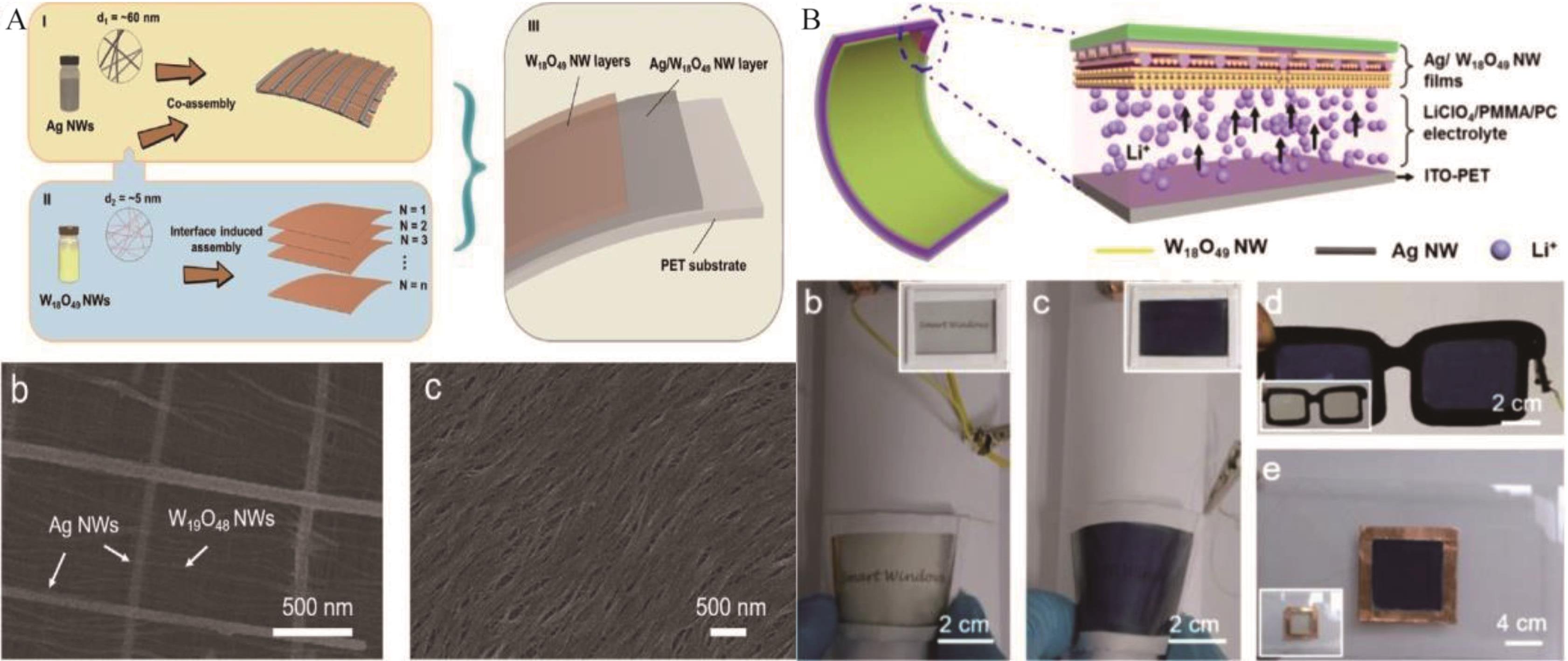
Fig.9 (A) Schematic illustration for the fabrication of flexible transparent electrodes (a) and SEM images of the co-assembled Ag/W18O49 NWs networks on the polyethylene terephthalate (PET) substrate (b-c). (B) Structural schematic diagram of solid electrochromic device (a) and Photographs of the bleached and colored state of solid electrochromic devices at bending state (b-c). The insets are photographs of the devices without bending. (d) Photographs of the electrochromic glasses model. (e) Photographs of the electrochromic window model[74]
| 1 | THOMPSON B C, SCHOTTLAND P, ZONG K W, et al. In situ colorimetric analysis of electrochromic polymers and devices[J]. Chem Mater, 2000, 12: 1563-1571. |
| 2 | PLATT J R. Electrochromism, a possible change of color producible in dyes by an electric field[J]. J Chem Phys, 1961, 34: 862-863. |
| 3 | DEB S K. A novel electrophotographic system[J]. Appl Optics, 1969, 8: 192-195. |
| 4 | GUERFI A, PAYNTER R W, DAO L H. Characterization and stability of electrochromic MoO3 thin-films prepared by electrodeposition[J]. J Electrochem Soc, 1995, 142: 3457-3464. |
| 5 | MONK P M S, ALI T, PARTRIDGE R D. The effect of doping electrochromic molybdenum oxide with other metal-oxides-correlation of optical and kinetic-properties[J]. Solid State Ionics, 1995, 80: 75-85. |
| 6 | SEO S, LEE M J, SEO D H, et al. Reproducible resistance switching in polycrystalline NiO films[J]. Appl Phys Lett, 2004, 85: 5655-5657. |
| 7 | ANISIMOV V I, SOLOVYEV I V, KOROTIN M A, et al. Density-functional theory and NiO photoemission spectra[J]. Phys Rev B, 1993, 48: 16929-16934. |
| 8 | GHICOV A, TSUCHIYA H, HAHN R, et al. TiO2 nanotubes: H+ insertion and strong electrochromic effects[J]. Electrochem Commun, 2006, 8: 528-532. |
| 9 | KOELSCH M, CASSAIGNON S, GUILLEMOLES J F, et al. Comparison of optical and electrochemical properties of anatase and brookite TiO2 synthesized by the sol-gel method[J]. Thin Solid Films, 2002, 403: 312-319. |
| 10 | KANG E T, NEOH K G, TAN K L. Polyaniline: a polymer with many interesting intrinsic redox states[J]. Prog Polym Sci, 1998, 23: 277-324. |
| 11 | WANG Y G, LI H Q, XIA Y Y. Ordered whiskerlike polyaniline grown on the surface of mesoporous carbon and its electrochemical capacitance performance[J]. Adv Mater, 2006, 18: 2619-2623. |
| 12 | BEEK W J E, WIENK M M, JANSSEN R A J. Hybrid solar cells from regioregular polythiophene and ZnO nanoparticles[J]. Adv Funct Mater, 2006, 16: 1112-1116. |
| 13 | KLINE R J, MCGEHEE M D, TONEY M F. Highly oriented crystals at the buried interface in polythiophene thin-film transistors[J]. Nat Mater, 2006, 5: 222-228. |
| 14 | MENON V P, LEI J T, MARTIN C R. Investigation of molecular and supermolecular structure in template-synthesized polypyrrole tubules and fibrils[J]. Chem Mater, 1996, 8: 2382-2390. |
| 15 | CHEN G Z, SHAFFER M S P, COLEBY D, et al. Carbon nanotube and polypyrrole composites: coating and doping[J]. Adv Mater, 2000, 12: 522-526. |
| 16 | CAI G F, EH A L S, JI L, et al. Recent advances in electrochromic smart fenestration[J]. Adv Sustain Syst, 2017, 1: 1700074. |
| 17 | 苑晓, 贺泽民, 张兰英, 等. 电致变色材料研究及发展现状[J]. 新材料产业, 2014, 5: 14-18. |
| YAN X, HE Z M, ZHANG L Y, et al. Research and development status of electrochromic materials[J]. Adv Mater Ind, 2014, 5: 14-18. | |
| 18 | 孙宁, 赵灵芝, 张玉杰. 电致变色薄膜研究进展[J]. 中国陶瓷, 1998, 5: 34-37. |
| SUN N, ZHAO L Z, ZHANG Y J. Advance in electrochromic films[J]. China Ceram, 1998, 5: 34-37. | |
| 19 | WEI Y X, ZHOU J L, ZHENG J M, et al. Improved stability of electrochromic devices using Ti-doped V2O5 film[J]. Electrochim Acta, 2015, 166: 277-284. |
| 20 | PURUSHOTHAMAN K K, MURALIADHARAN G. The effect of annealing temperature on the electrochromic properties of nanostructured NiO films[J]. Sol Energy Mater Sol Cells. 2009, 93: 1195-1201. |
| 21 | ZRIKEM K, SONG G, AGHZZAF A A, et al.UV treatment for enhanced electrochromic properties of spin coated NiO thin films[J]. Superlattice Microst, 2019, 127: 35-42. |
| 22 | 王金敏, 后丽君, 马董云. 氧化钼电致变色材料与器件[J]. 无机材料学报, 2021, 36(5): 461-470. |
| WANG J M, HOU L J, MA D Y. Molybdenum oxide electrochromic materials and devices[J]. J Inorg Mater, 2021, 36(5): 461-470. | |
| 23 | REN Y, CHIM W K, GUO L, et al. The coloration and degradation mechanisms of electrochromic nickel oxide[J]. Sol Energy Mater Sol Cells, 2013, 116: 83-88. |
| 24 | XIE Z, LIU Q, ZHANG Q, et al. Fast-switching quasi-solid state electrochromic full device based on mesoporous WO3 and NiO thin films[J]. Sol Energy Mater Sol Cells, 2019, 200: 110017. |
| 25 | XIE Z, LIU Q, LU B, et al. Large coloration efficiency and fast response NiO electrochromic thin film electrode based on NiO nanocrystals[J]. Mater Today Commun, 2019, 21: 100635. |
| 26 | FIRAT Y E, PEKSOZ A. Efficiency enhancement of electrochromic performance in NiO thin film via Cu doping for energy-saving potential[J]. Electrochim Acta, 2019, 295: 645-654. |
| 27 | 成明, 杨继凯, 杨馥瑜, 等. WO3/TiO2复合薄膜的制备及其电致变色性能[J]. 复合材料学报, 2019, 36(4): 914-920. |
| CHENG M, YANG J K, YANG F Y, et al. Preparation and electrochromic properties of WO3/TiO2 composite films[J]. Acta Mater Compos Sin, 2019, 36(4): 914-920. | |
| 28 | TANG K, ZHANG Y, SHI Y D, et al. Fabrication of WO3/TiO2 core-shell nanowire arrays: structure design and high electrochromic performance[J]. Electrochim Acta, 2020, 330: 135189. |
| 29 | WANG Z X, WANG H, GU X, et al. Hierarchical structure WO3/TiO2 complex film with enhanced electrochromic performance[J]. Solid State Ionics, 2019, 338: 168-176. |
| 30 | XIONG S X, YIN S Y, WANG Y Y, et al. Organic/inorganic electrochromic nanocomposites with various interfacial interactions: a review[J]. Mater Sci Eng B: Adv, 2017, 221: 41-53. |
| 31 | REYES-GIL K R, STEPHENS Z D, STAVILA V, et al. Composite WO3/TiO2 nanostructures for high electrochromic activity[J]. ACS Appl Mater Inter, 2015, 7: 2202-2213. |
| 32 | 刘雪晴, 钟晓岚, 刁训刚. 氧化镍基电致变色薄膜与器件研究进展[J]. 真空与低温, 2020, 5: 345-360. |
| LIU X Q, ZHONG X L, DIAO X G. Advances in electrochromic films and devices based on nickel oxide[J]. Vacuum Cryogenics, 2020, 5: 345-360. | |
| 33 | YU J H, YANG H, JUNG R H, et al. Hierarchical NiO/TiO2 composite structures for enhanced electrochromic durability[J]. Thin Solid Films, 2018, 664: 1-5. |
| 34 | BO G S, WANG X, WANG K, et al. Preparation and electrochromic performance of NiO/TiO2 nanorod composite film[J]. J Alloy Compd, 2017, 728: 878-886. |
| 35 | QI X Y, SU G, BO G S, et al. Synthesis of NiO and NiO/TiO2 films with electrochromic and photocatalytic activities[J]. Surf Coat Tech, 2015, 272: 79-85. |
| 36 | CAI G F, TU J P, ZHOU D, et al. Constructed TiO2/NiO core/shell nanorod array for efficient electrochromic application[J]. J Phys Chem C, 2014, 118: 6690-6696. |
| 37 | 亢嘉琪, 杨继凯, 杨馥瑜, 等. TiO2/MoO3复合薄膜的制备及其电致变色性能研究[J]. 光子学报, 2018, 47(3): 75-83. |
| KANG J Q, YANG J K, YANG F Y, et al. Preparation and electrochromic properties of TiO2/MoO3 composite film[J]. Acta Photonic Sin, 2018, 47(3): 75-83. | |
| 38 | XU H B, GONG L T, ZHOU S Y, et al. Enhancing the electrochromic stability of prussian blue based on TiO2 nanorod arrays[J]. New J Chem, 2020, 44: 2236-2240. |
| 39 | WANG X, LIU B, TANG J, et al.Preparation of Ni(OH)2 /TiO2 porous film with novel structure and electrochromic property[J]. Sol Energy Mater Sol Cells, 2019, 191: 108-116. |
| 40 | WEI W, GU X Y, LIU Y Z, et al. Three-dimensional structures of nanoporous NiO/ZnO nanoarray films for enhanced electrochromic performance[J]. Chem-Asian J, 2019, 14: 431-437. |
| 41 | TAN S J, GAO L, WANG W Q, et al. Preparation and black-white electrochromic performance of the non-contact ZnO@NiO core-shell rod array[J]. Surf Interfaces, 2022, 30: 101889. |
| 42 | KOO B R, BAE J W, AHN H J. Percolation effect of V2O5 nanorod/graphene oxide nanocomposite films for stable fast-switching electrochromic performances[J]. Ceram Int, 2019, 45: 12325-12330. |
| 43 | LANG F P, LIU J B, WANG H, et al. NiO nanocrystalline/reduced graphene oxide composite film with enhanced electrochromic properties[J]. Nano, 2017, 12: 1750058. |
| 44 | WU J, QIU D, ZHANG H L, et al. Flexible electrochromic V2O5 thin films with ultrahigh coloration efficiency on graphene electrodes[J]. J Electrochem Soc, 2018, 165: D183-D189. |
| 45 | KHAN A, BHOSALE N Y, MALI S S, et al, Reduced graphene oxide layered WO3 thin film with enhanced electrochromic properties[J]. J Colloid Interf Sci, 2020, 571: 185-193. |
| 46 | THONGPAN W, LOULOUDAKIS D, POOSEEKHEAW P, et al. Porous CuWO4/WO3 composite films with improved electrochromic properties prepared by sparking method[J]. Mater Lett, 2019, 257: 126747. |
| 47 | LIU Y, YUAN G Z, HUA C Z, et al. Improvement of electrochromic performance by embedding ITO nanocrystals in amorphous WO3 film[J]. Ecs J Solid State Sc, 2019, 8: P1-P6. |
| 48 | GARCIA-LOBATO M A, GARCIA C R, MTZ-ENRIQUEZ A I, et al. Enhanced electrochromic performance of NiO-MWCNTs thin films deposited by electrostatic spray deposition[J]. Mater Res Bull, 2019, 114: 95-100. |
| 49 | WANG W Q, LI Z X, YU Z F, et al. The stabilization of Ni(OH)2 by In2O3 rods and the electrochromic performance of Ni(OH)2/In2O3-rod composite porous film[J]. Thin Solid Films, 2021, 734: 138839. |
| 50 | NAJAFI-ASHTIANI H, BAHARI A, GHOLIPOUR S. Investigation of coloration efficiency for tungsten oxide-silver nanocomposite thin films with different surface morphologies[J]. J Mater Sci-Mater El, 2018, 29: 5820-5829. |
| 51 | HSIAO Y S, CHANG-JIAN C W, SYU W L, et al. Enhanced electrochromic performance of carbon-coated V2O5 derived from a metal-organic framework[J]. Appl Surf Sci, 2021, 542: 148498. |
| 52 | CHANG C C, CHI P W, CHANDAN P, et al. Electrochemistry and rapid electrochromism control of MoO3/V2O5 hybrid nanobilayers[J]. Materials, 2019, 12: 2475. |
| 53 | 岳言芳, 李海增, 李克睿, 等. NiO/PB复合电致变色薄膜的制备及其性能研究[J]. 无机材料学报, 2017, 32(9): 949-954. |
| YUE Y F, LI H Z, LI K R. et al. Preparation and properties of NiO/PB hybrid electrochromic film[J]. J Inorg Mater, 2017, 32(9): 949-954. | |
| 54 | CHEN Y B, BI Z J, LI X M, et al. High-coloration efficiency electrochromic device based on novel porous TiO2@prussian blue core-shell nanostructures[J]. Electrochim Acta, 2017, 224: 534-540. |
| 55 | MISHRA S, YOGI P, SAGDEO P R, et al. TiO2-Co3O4 core-shell nanorods: bifunctional role in better energy storage and electrochromism[J]. ACS Appl Energ Mater, 2018, 1: 790-798. |
| 56 | JIANG S S, YUAN G Z, HUA C Z, et al. Electrochromic properties of Ni/NiO/rGO nanocomposite films prepared by a facile sol-gel technique[J]. J Electrochem Soc, 2017, 164: H896-H902. |
| 57 | JITTIARPORN P, SIKONG L, KOOPTARNOND K, et al. Electrochromic properties of MoO3-WO3 thin films prepared by asol-gel method, in the presence of atriblock copolymer template[J]. Surf Coat Tech, 2017, 327: 66-74. |
| 58 | GRANQVIST C G. Electrochromics for smart windows: oxide-based thin films and devices[J]. Thin Solid Films, 2014, 564: 1-38. |
| 59 | SVENSSON J, GRANQVIST C G. Electrochromic coatings for “smart windows”[J]. Sol Energy Mater Sol Cells, 1985, 12(6): 391-402. |
| 60 | THAKUR V K, DING G Q, MA J, et al. Hybrid materials and polymer electrolytes for electrochromic device applications[J]. Adv Mater, 2012, 24(30): 4071-4096. |
| 61 | SHIMIZU Y, FURUTA S. An opto-electrochemical phosphate-ion sensor using a cobalt-oxide thin-film electrode[J]. Solid State Ionics, 1998, 113/114/115: 241-245. |
| 62 | MELVILLE O A, LESSARD B H, BENDER T P. Phthalocyanine-based organic thin-film transistors: areview of recent advances[J]. ACS Appl Mater Interfaces, 2015, 7: 13105-13118. |
| 63 | IBARAKI N, KOMAKI T, KIMURA M. Introduction special section based on presentations from the 18th international display workshops (IDW '11) [J]. J Soc Inf Display, 2012, 20: 485-485. |
| 64 | HALL D S, LOCKWOOD D J, BOCK C, et al. Nickel hydroxides and related materials: a review of their structures, synthesis and properties[J]. P Roy Soc A:Math Phy Sci, 2015, 471(2174): 65. |
| 65 | 张旭苹. 电致变色灵巧窗的设计与研制[J]. 太阳能学报, 1997, 18(4): 415-420. |
| ZHANG X P. The design and preparation of electrochromic smart windows[J]. Acta Energiae Solaris Sin, 1997, 18(4): 415-420. | |
| 66 | 冯博学, 陈冲, 何毓阳, 等.电致变色材料及器件的研究进展[J]. 功能材料, 2004, 35(2): 145-150. |
| FENG B X, CHEN C, HE Y Y, et al. Advance in research on electrochromic materials and devices[J]. J Funct Mater, 2004, 35(2): 145-150. | |
| 67 | ATAK G, COSKUN O. Fabrication of an all solidstate electrochromic device using zirconium dioxide as an ion-conducting layer[J]. Thin Solid Films, 2018, 664: 70-78. |
| 68 | COSKUN O, ATAK G. The effects of lithiation process on the performance of all-solid-state electrochromic devices[J]. Thin Solid Films, 2018, 662: 13-20. |
| 69 | 张旭苹, 陈国平. 电致变色智能玻璃研究的现状[J]. 新型建筑材料, 1995(9): 16-20. |
| ZHANG X P, CHEN G P. The advances of electrochromic smart glass[J]. New Building Mater, 1995(9): 16-20. | |
| 70 | SONG X W, DONG G B, GAO F Y, et al. Properties of NiOx and its influence upon all-thin-film ITO/NiOx/LiTaO3/WO3/ITO electrochromic devices prepared by magnetron sputtering[J].Vacuum, 2015, 111: 48-54. |
| 71 | ZHANG X P, ZHANG H K, LI Q, et al. An all-solid-state inorganic electrochromic display of WO3 and NiO films with LiNbO3 ion conductor[J]. IEEE Electron Device Lett, 2000, 21(5): 215-217. |
| 72 | 崔敏慧, 吴正华, 邱思畴, 等. 聚氧乙烯-高氯酸锂配合物电致变色光窗的研究[J]. 应用化学, 1996, 13(6): 39-41. |
| CUI M H, WU Z H, QIU S C, et al. Electrochromic window based on polyoxyethylene-lithium perchlorate complex[J]. Chinese J Appl Chem, 1996, 13(6): 39-41. | |
| 73 | YU H F, KAOA S Y, LUA H C. Electrospun nanofibers composed of poly(vinylidenefluoride-co-hexafluoropropylene) and poly(oxyethylene)-imide imidazolium tetrafluoroborate as electrolytes for solid-state electrochromic devices[J]. Sol Energy Mater Sol Cells, 2018, 177: 32-43. |
| 74 | WANG J L, LU Y R, LI H H, et al. Large area co-assembly of nanowires for flexible transparent smart windows[J]. J Am Chem Soc, 2017, 139: 99219926. |
| 75 | LI W J, ZHANG X, CHEN X, et al. Long life all-solid-state electrochromic devices by annealing[J]. Sol Energy Mater Sol Cells, 2021, 224: 110992. |
| 76 | ZHAO Y M, ZHANG X, CHEN X, et al. Preparation of Sn-NiO films and all-solid-state devices with enhanced electrochromic properties by magnetron sputtering method[J]. Electrochim Acta, 2021, 367: 137457. |
| [1] | Xing-Mei HU, Jin-Hong ZHANG, Yu-Lin MO, Hai-Bin LIN. Designing Dual-output Digital Logic Circuits Based on the Combination of Bovine Serum Albumin and Schiff Base [J]. Chinese Journal of Applied Chemistry, 2023, 40(6): 904-915. |
| [2] | Lu-Fei WANG, Meng-Meng ZHEN, Bo-Xiong SHEN. Research Progress of Controlling Lithium-Sulfur Batteries by Electrocatalysts under Lean Electrolyte Conditions [J]. Chinese Journal of Applied Chemistry, 2023, 40(2): 188-209. |
| [3] | Xue-Jian SHI, Wan-Qiang LIU, Chun-Li WANG, Yong CHENG, Li-Min WANG. Research Progress of Sb-based Anode Materials for Potassium Ion Batteries [J]. Chinese Journal of Applied Chemistry, 2023, 40(2): 210-228. |
| [4] | Lin-Hu SONG, Shi-You LI, Jie WANG, Jing-Jing ZHANG, Ning-Shuang ZHANG, Dong-Ni ZHAO, Fei XU. Research Progress of Additives for Acid and Water Removal in Electrolyte of Lithium Ion Battery [J]. Chinese Journal of Applied Chemistry, 2022, 39(5): 697-706. |
| [5] | Guo-Hua DONG, Li-Juan HAO, Wen-Zhi ZHANG, Dong-Feng CHAI, Ming ZHAO, Kun LANG. Recent Progress on the Application of Carbon Quantum Dots Nano⁃materials in Lead Halogen Perovskite Solar Photoelectric Devices [J]. Chinese Journal of Applied Chemistry, 2022, 39(5): 707-722. |
| [6] | Jing ZHOU, Yu-Xuan CHEN, Jun-Ming MA, Xiao-Fei ZHU, De-Feng ZHOU. Effect of MgO and Fe2O3 Incorporation on the Microstructure and Electrochemical Performance of GDCSi System [J]. Chinese Journal of Applied Chemistry, 2022, 39(5): 809-818. |
| [7] | Qi ZHANG, Qian ZHANG, Xiao-Meng SHI, Ya-Qi KONG, Ke-Xin GAO, Ya-Ping DU. Research Progress of Rare Earth Bromides Based Solid Electrolytes for All⁃Solid⁃State Batteries [J]. Chinese Journal of Applied Chemistry, 2022, 39(4): 585-598. |
| [8] | Yong-Peng LYU, Yu-Ge WANG, Qian-Qian GU, Zhi-Cai ZHANG, Jian-Shu XIAO, Yuan YIN, Hong-Guo SUN, Ya-Fang ZHENG, Zhao-Yan SUN. Dispersion of Carbon Black in Isoprene Rubber and Its Static and Dynamic Properties [J]. Chinese Journal of Applied Chemistry, 2022, 39(12): 1842-1853. |
| [9] | WANG Xu-Yao, FANG Ying-Jun, ZHANG Ling-Zhi. Synthesis and Characterization of Cross-linked Solid Polymer Electrolyte Based on N-Cyanoethylated Polyethylenimine for Lithium-Ion Batteries [J]. Chinese Journal of Applied Chemistry, 2021, 38(8): 946-953. |
| [10] | SUI Li-Li, JIANG Hui-Ye, WANG Di, HUANG Wei-Wei, SUI Wei-Wei, SHEN Shu-Chang, WANG Ping, ZHANG Wen-Zhi, WANG Wen-Bo, ZHAO Bing, LIU Yong-Zhi. Construction of Hierarchical NiO Microspheres and the Adsorption Capacity to Congo Red Azo-dye [J]. Chinese Journal of Applied Chemistry, 2021, 38(4): 447-456. |
| [11] | LIN Qiu-Peng, ZHANG Zhu-Ying, SHI Dong-Jian, PEI Ze-Jun, CHEN Ming-Qing, NI Zhong-Bin. Preparation and Properties of Sustained Release Chitosan/Chlorhexidine Acetate Composite Microspheres [J]. Chinese Journal of Applied Chemistry, 2021, 38(12): 1599-1611. |
| [12] | ZHANG Xiaobo, XIN Haiying, XU Shuang, ZHANG Xinghai, WANG Liqiu. Cellulose Gel Polymer Electrolytes and Its Application in Supercapacitors [J]. Chinese Journal of Applied Chemistry, 2020, 37(5): 547-554. |
| [13] | ZHANG Xiaobo, XIN Haiying, XU Shuang, ZHANG Xinghai, WANG Liqiu. Cellulose Gel Polymer Electrolytes and Its Application in Supercapacitors [J]. Chinese Journal of Applied Chemistry, 2020, 37(5): 0-. |
| [14] | FAN Liming,WANG Shimao,YE Yuqi,DING Bowen,SHAN Xueyan,MENG Gang,FANG Xiaodong. Recent Advances in Rational Synthesis and Applications of Halide Perovskite Micro/Nano-Arrays [J]. Chinese Journal of Applied Chemistry, 2020, 37(4): 367-379. |
| [15] | ZHANG Zhuanfang, ZHENG Jianhua, XIN Jianjiao, ZHAO Nan, CHEN Jie, XU Rui. Syntheses and Catalytic Properties of Keggin-Type Polyoxometalate-Based Crystal Materials [J]. Chinese Journal of Applied Chemistry, 2020, 37(4): 481-488. |
| Viewed | ||||||
|
Full text |
|
|||||
|
Abstract |
|
|||||
